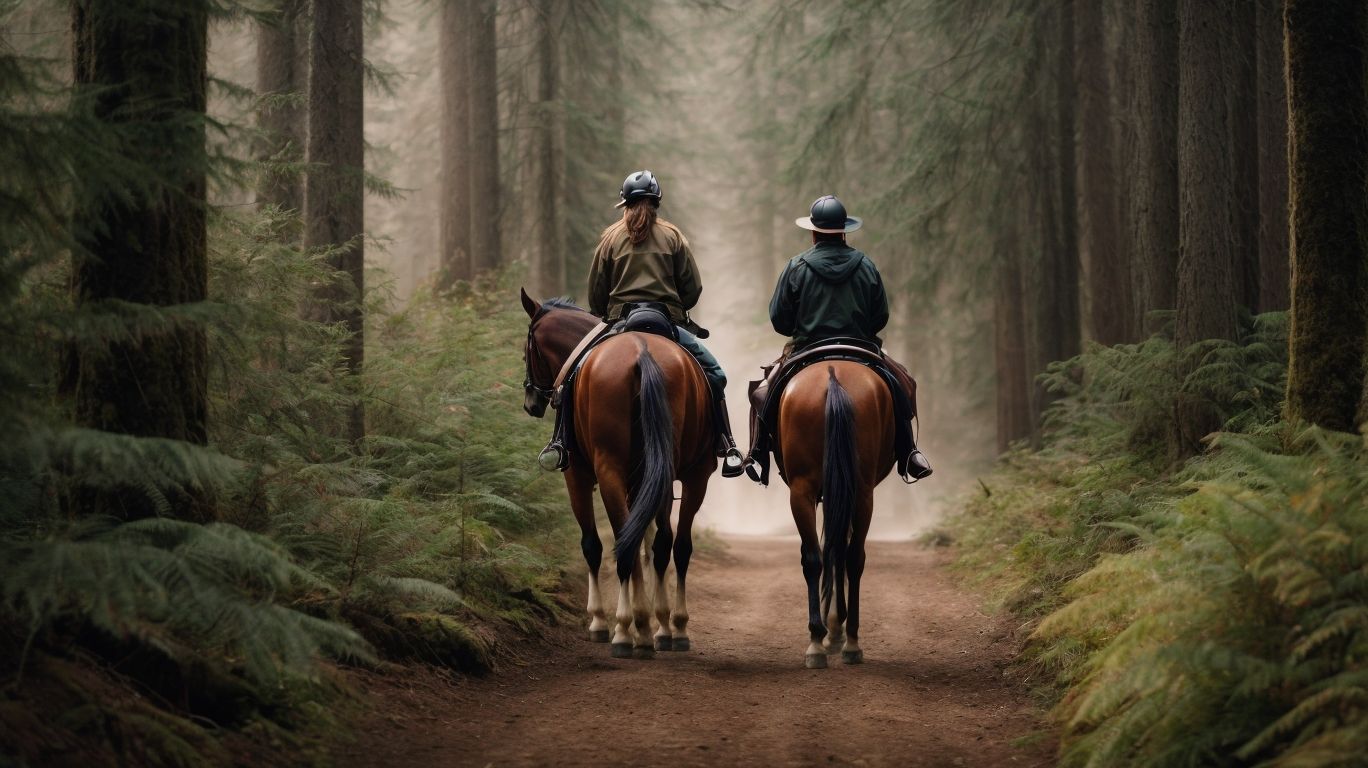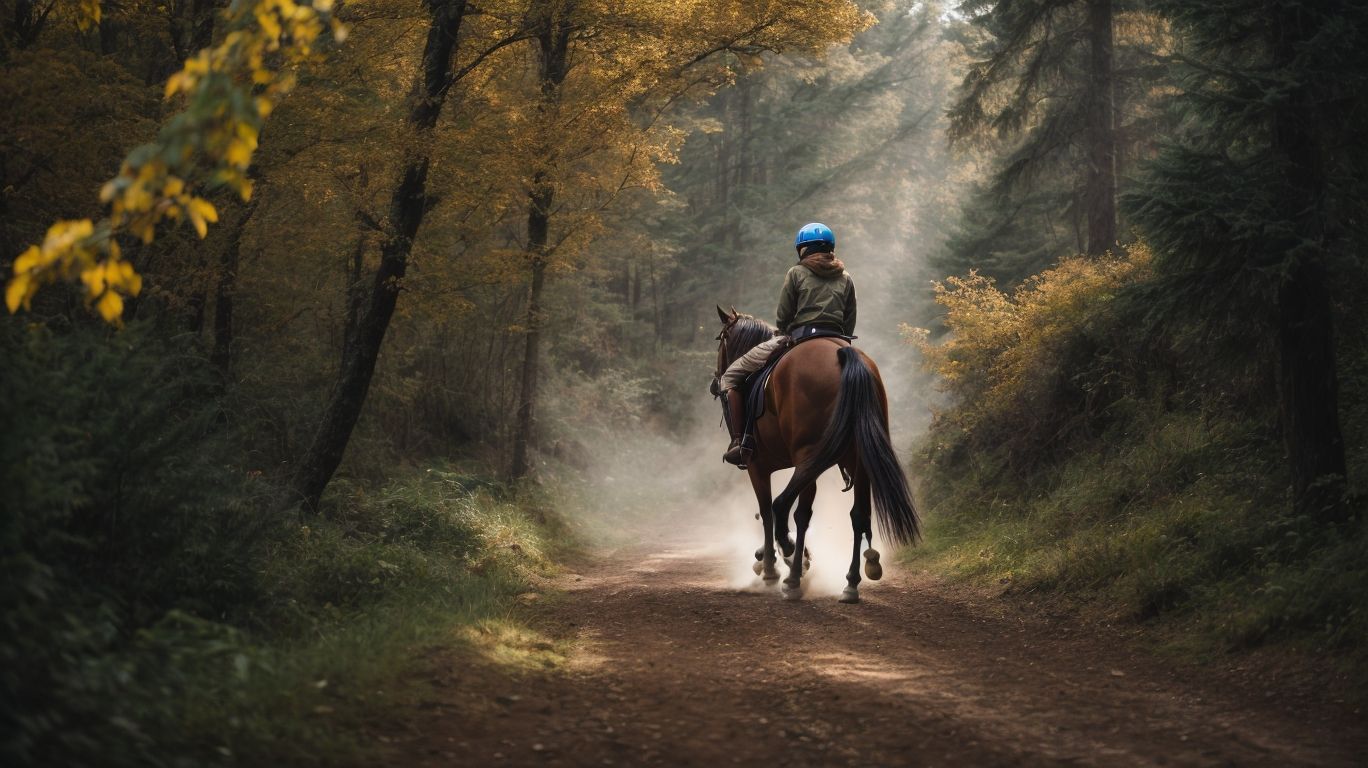Horse behavior management is essential for ensuring a safe and enjoyable experience when training for trail riding etiquette. Understanding horse behavior plays a crucial role in effectively managing and training horses. By referencing established equestrian experts like Monty Roberts and Charlotte Dujardin, we can gain valuable insights into horse behavior and training methodologies.
Behavior management is particularly important in horse training as it establishes a foundation of trust, respect, and communication between the rider and the horse. A well-trained horse exhibits good behavior, making it easier to navigate trails and interact with other riders and horses.
Trail riding etiquette is of utmost importance to ensure the safety and harmony of the equestrian community. Following proper etiquette helps prevent accidents, improves the overall trail riding experience, and promotes a positive image of horse riders.
Understanding why trail riding etiquette is important lays the groundwork for its application. Basic training for trail riding focuses on teaching horses essential skills like responding to cues, maintaining a calm demeanor, and being comfortable in various trail conditions.
Riders should adhere to specific tips for practicing proper trail riding etiquette, such as respecting right-of-way, maintaining a safe distance from other horses, and leaving no trace by cleaning up after their horses.
However, trail riding comes with its challenges, ranging from encountering wildlife to navigating obstacles. Overcoming these challenges requires proper training techniques that promote trust and confidence in the horse. Consistency in training and using appropriate tools and techniques, like desensitization exercises and positive reinforcement, can aid in achieving trail riding success.
By effectively managing horse behavior and training for trail riding etiquette, equestrians can enjoy safe and enjoyable experiences on the trail while fostering a sense of community and respect among riders.
Key takeaway:
- Understanding horse behavior is crucial: Properly managing horse behavior is essential when training for trail riding etiquette. By understanding their natural instincts and behaviors, trainers can set realistic expectations and address any issues that may arise.
- Consistency is key in trail riding training: Consistent training methods and expectations help horses understand what is expected of them on the trail. By establishing consistent cues and following through with appropriate rewards and corrections, riders can create a safe and enjoyable experience for everyone.
- Building trust and confidence is essential: Trail riding can be an unfamiliar and potentially stressful experience for horses. Building trust and confidence through positive reinforcement and exposure to different environments can help horses feel more comfortable and confident on the trail.
Horse Behavior Management

Photo Credits: Www.Horsespeakeducation.Com by Alan Torres
When it comes to horse behavior management, understanding their innate disposition is key. In this section, we’ll dig into the intricacies of horse behavior, exploring why it’s crucial for successful training and safety. Get ready to uncover the secrets behind establishing a harmonious relationship with these majestic creatures, as we delve into the importance of behavior management in horse training. So saddle up and join us on this enlightening journey to understanding and managing the behavior of our equine friends.
Understanding Horse Behavior
Understanding horse behavior is vital when it comes to training and handling these magnificent creatures. Horses, being herd animals, possess innate behaviors that play a significant role in their reactions and responses. It is essential to take into account several key aspects, such as their natural flight instinct, herd hierarchy, body language signals, and social interactions. By familiarizing themselves with these behaviors, trainers and handlers can foresee and appropriately address any potential issues that may arise. A valuable tip is to spend ample time observing and engaging with horses in various environments. This practice allows for a profound comprehension of their behavior and the opportunity to establish a profound bond based on trust and mutual respect.
Importance of Behavior Management in Horse Training
The importance of behavior management in horse training cannot be overstated. It plays a crucial role in establishing a strong foundation and promoting safety for both the horse and rider. By utilizing effective behavior management techniques, trainers can teach horses to respond appropriately to cues and commands, thus reducing the risk of accidents and improving overall performance. These techniques also address issues such as spookiness, aggression, or disobedience. Through the implementation of consistent and positive reinforcement methods, along with clear communication, trainers help horses understand what is expected of them during training sessions. Ultimately, behavior management is essential for building a successful and harmonious partnership between horse and rider.
Training for Trail Riding Etiquette

Photo Credits: Www.Horsespeakeducation.Com by Arthur Ramirez
Incorporating training for trail riding etiquette is crucial to ensure a safe and enjoyable experience for both riders and horses. Here are some vital considerations:
- Lead training: It is essential to teach your horse to follow calmly behind you while maintaining a safe distance.
- Passing etiquette: Train your horse to yield to other riders when passing by moving off the trail or stopping completely.
- Trail manners: Practicing good trail manners includes not littering, staying on designated trails, and respecting other trail users.
- Terrain familiarity: Expose your horse to different trail terrains and obstacles to build confidence and prevent spooking.
- Communication cues: Develop clear communication cues to guide your horse through trail obstacles, such as logs or water crossings.
Keep in mind that training for trail riding etiquette is an ongoing process. Be patient and consistent, always prioritizing safety for yourself, your horse, and others on the trail.
Why is Trail Riding Etiquette Important?
<strong>Trail riding etiquette</strong> is crucial for numerous reasons. One of the main objectives is to prioritize the safety of both riders and horses, guaranteeing a smooth and incident-free experience. Proper etiquette also allows trail users to coexist harmoniously, which helps to avoid accidents at intersections or on narrow trails. Moreover, it demonstrates respect towards fellow riders, hikers, and trail users, establishing a positive and enjoyable atmosphere. By following trail riding etiquette, individuals are able to minimize the impact of horse travel on the natural environment, thereby helping to preserve it. Additionally, adhering to these guidelines enables riders to build a solid reputation within the equestrian community and increases their chances of being welcome to ride in various locations.
<strong>Pro-tip:</strong> Always remain mindful of others on the trail and diligently practice good trail riding etiquette. This not only enhances the enjoyment of your rides, but also contributes to fostering a positive and supportive equestrian community.
Basic Training for Trail Riding
When it comes to basic training for trail riding, there are several key steps to consider. Ensure your horse is physically prepared for the demands of trail riding by engaging in regular exercise and conditioning to build strength and stamina. Introduce your horse gradually to different environments and stimuli, such as riding on different terrains, encountering various obstacles, and exposure to different weather conditions. Teach your horse the basic trail riding commands, including stopping, starting, turning, and transitioning between gaits. It is beneficial to practice riding in a group or with other horses to familiarize your horse with riding in a social setting and to learn how to maintain a safe distance between horses. Train your horse to navigate common trail obstacles, such as crossing water, stepping over logs, and going through narrow passages. Additionally, it is important to train your horse to remain calm and responsive to your cues, even in potentially challenging situations, like encountering wildlife or loud noises. Emphasize the importance of trail etiquette, which includes yielding to other trail users, closing gates, minimizing impact on the environment, and communicating when passing others. By following these basic training steps, both you and your horse will be prepared for a safe and enjoyable trail riding experience.
Tips for Proper Trail Riding Etiquette
When it comes to proper trail riding etiquette, there are some important tips that every rider should keep in mind to ensure a safe and enjoyable experience:
- Always remember these tips for proper trail riding etiquette:
- Yield to hikers, bikers, and vehicles, as they may not be able to easily maneuver around you.
- Ride in a single file to minimize your impact on the trail and allow others to pass.
- When passing other horses, give them plenty of space and always ask for permission from the other rider.
- Be aware of your horse’s behavior and keep them under control to prevent any unsafe situations.
- Respect private property and follow any specific use regulations or restrictions.
By following these tips for proper trail riding etiquette, you can ensure that you are creating a positive atmosphere for all trail users.
In 1861, a group of riders in the small town of Greenfield, Massachusetts organized the first official trail ride, covering a distance of 10 miles. This event sparked a newfound interest in trail riding, leading to the development of dedicated trail systems and the establishment of trail riding clubs across the country.
Common Challenges and How to Overcome Them
- Uneven terrain can be a common challenge for trail riders. To improve balance and stability, it is important to practice riding on different types of terrain.
- Spooking is another common challenge faced by trail riders. Gradually exposing your horse to different stimuli using desensitization techniques and positive reinforcement can help in overcoming this challenge.
- Trail obstacles such as water crossings and bridges can also pose a challenge. To overcome this, it is important to familiarize your horse with these obstacles gradually, building their confidence over time.
- Group dynamics can prove to be a challenge during trail riding. Training your horse to ride in a group, maintaining a safe distance, and following cues from the lead rider can help overcome this challenge.
- Another important aspect of trail riding is to understand and practice proper trail etiquette. This includes respecting other trail users and minimizing the impact on the environment.
Fact: Overcoming common challenges in trail riding not only improves your own skills as a rider, but also strengthens the bond and trust between you and your horse.
Importance of Consistency in Training
- The importance of consistency in training plays a crucial role in effectively teaching and maintaining desired behaviors in horses.
- Clear Communication: Consistency helps establish clear communication between the trainer and the horse, ensuring that the horse understands the cues and expectations.
- Reinforcement of Learning: Consistent repetition of training exercises reinforces the learning process, allowing the horse to understand and respond to commands consistently.
- Prevention of Confusion: Inconsistent training can confuse the horse, leading to mixed signals and behavioral issues. Consistency helps eliminate confusion and promotes focused and reliable responses.
- Building Trust: Consistency in training builds trust between the horse and the trainer, as the horse learns to rely on consistent cues and reinforcement.
- Effective Progression: Consistency allows for structured and progressive training, building upon previously learned behaviors and gradually introducing new commands and challenges.
Building Trust and Confidence on the Trail
- Achieving Trust and Confidence on the Trail
- Groundwork: The Foundation for Trust and Confidence
- Gradual Exposure: Building Trust One Step at a Time
- Positive Reinforcement: Rewarding Trust and Brave Behavior
- Encouraging Curiosity: Fostering Confidence in New Surroundings
- Leadership: A Consistent and Confident Guide
- Staying Calm and Relaxed: A Key to Building Trust
- Consistency: Creating Security and Confidence
Tools and Techniques for Trail Riding Training
When it comes to trail riding training, there are several tools and techniques that can enhance your experience and ensure the safety of both you and your horse.
- Trail maps: Familiarize yourself with the trails in your area and always carry a map to navigate different terrains.
- Specific equipment: Invest in proper gear such as ASTM/SEI approved helmets, first aid kits, and identification tags for your horse.
- Simulated trail rides: Practice riding in different environments, such as wooded areas or open fields, to expose your horse to various stimuli.
- Group riding: Arrange rides with experienced riders and reliable friends to learn from their expertise and improve your horsemanship skills.
- Building trust: Establish a bond of trust and understanding with your horse through consistent training and positive reinforcement.
Some Facts About Horse Behavior Management – Training for Trail Riding Etiquette:
- ✅ It is important to know the rules of etiquette for riding cross-country, as it ensures a positive experience and allows for continued access to riding areas. (Source: Our Team)
- ✅ Yielding to other trail users is a fundamental rule of trail etiquette, with cyclists yielding to hikers and horses, and hikers yielding to horses. (Source: Horse Journals)
- ✅ Bringing inexperienced horses to multi-use trails is not recommended, as it may put both the horse and rider at risk. (Source: Horse Journals)
- ✅ Regularly checking tack for proper fit is essential to ensure the comfort and safety of the horse during trail rides. (Source: Horse Journals)
- ✅ Carrying a cell phone, trail map, compass, and a first aid kit for both humans and horses is crucial for preparedness and safety during trail riding. (Source: Horse Journals)
Frequently Asked Questions
What are some common trail etiquette reminders for riders?
Some common trail etiquette reminders for riders include always closing gates, staying on existing trails, minimizing impact on the land, yielding to hikers and horses, and being friendly and courteous towards other trail users.
How should riders handle passing each other on the trail?
When passing other riders on the trail, it is important to maintain a distance of one to two horse lengths back. Riders should communicate their presence with a friendly greeting and ask for permission to pass. It is polite to let others know if you plan on passing more than one horse.
What should riders do when encountering hikers, bikers, or vehicles on the trail?
According to trail etiquette rules, riders should yield to hikers and bikers, and both hikers and riders should yield to vehicles. It is essential to be aware of other trail users and communicate your presence to avoid any accidents or misunderstandings.
Is it advisable to bring an inexperienced horse for trail riding?
It is not recommended to bring an inexperienced horse to a trail ride, especially on multi-use trails. Inexperienced horses may have difficulty adapting to new environments, encounter behavioral issues, or pose a risk to the rider’s safety. It is best to gain experience in a controlled environment before attempting trail riding.
How should riders handle crossing roads during a trail ride?
When crossing a road during a trail ride, riders should follow road safety rules and stay on the right side of the road. It is important to be cautious and ensure the safety of both the rider and the horse when interacting with vehicular traffic.
What equipment should riders carry for trail riding?
Riders should carry essential equipment such as a cell phone, trail map, and compass on their person, not on the horse. It is also recommended to carry a first aid kit for both humans and horses, insect repellent, an ASTM/SEI approved riding helmet, and to attach an identification tag to the horse’s gear for identification purposes. Distributing weight evenly in saddle bags is also important for load balance.
